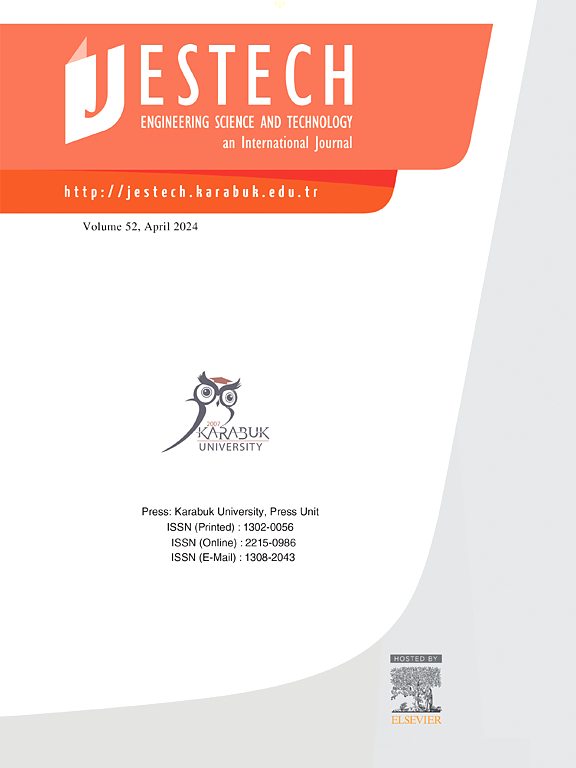Grounding DINO and distillation-enhanced model for advanced traffic sign detection and classification in autonomous vehicles
IF 5.1
2区 工程技术
Q1 ENGINEERING, MULTIDISCIPLINARY
Engineering Science and Technology-An International Journal-Jestech
Pub Date : 2025-03-10
DOI:10.1016/j.jestch.2025.102028
引用次数: 0
Abstract
Accurate traffic sign detection is critical for safe autonomous driving. This paper presents a novel approach that integrates GroundingDINO, known for its semantic grounding capabilities, with a self-distilled ResNet to enhance detection performance and real-time feasibility. While GroundingDINO excels in linking object detection with contextual understanding, it faces challenges when detecting small or occluded signs. To address these limitations, we employ a lightweight LB-scSE (Linear Bottleneck Block with Simultaneous Spatial and Channel Squeeze & Excitation) architecture, thereby improving detection accuracy while significantly reducing computational overhead.
We evaluate our framework on the custom DINO>SRBv1 dataset, where the GroundingDINO Pro model achieves a mAP@50 of 68.52%. The self-distilled network further reduces model size by tenfold compared to baseline models (e.g., MobileNetV2, VGG16, ResNet18), yet maintains competitive accuracy, providing a robust, resource-efficient solution for real-time deployment. Our results indicate that integrating semantic grounding with distillation-based compression not only enhances traffic sign detection performance but also delivers a scalable and efficient approach for complex traffic environments. Additionally, our method outperforms standard architectures such as MobileNetV1-2, VGG16-19, and ResNet34-50, demonstrating higher detection accuracy and lower resource consumption, thus reinforcing its suitability for real-world autonomous driving scenarios.
基于DINO和蒸馏增强模型的自动驾驶汽车高级交通标志检测和分类
准确的交通标志检测对于安全的自动驾驶至关重要。本文提出了一种将GroundingDINO(以其语义接地能力而著称)与自蒸馏ResNet相结合的新方法,以提高检测性能和实时可行性。虽然GroundingDINO在将目标检测与上下文理解联系起来方面表现出色,但在检测小或遮挡的标志时面临挑战。为了解决这些限制,我们采用了轻量级的LB-scSE(同时具有空间和通道挤压的线性瓶颈块)。激励)架构,从而提高检测精度,同时显着降低计算开销。我们在自定义dino & &;GTSRBv1数据集上评估我们的框架,其中GroundingDINO Pro模型达到了mAP@50的68.52%。与基线模型(例如,MobileNetV2, VGG16, ResNet18)相比,自提取网络进一步减少了模型尺寸的十倍,但保持了竞争力的准确性,为实时部署提供了强大的,资源高效的解决方案。我们的研究结果表明,将语义基础与基于蒸馏的压缩相结合不仅提高了交通标志检测性能,而且为复杂的交通环境提供了一种可扩展和高效的方法。此外,我们的方法优于MobileNetV1-2、VGG16-19和ResNet34-50等标准架构,具有更高的检测精度和更低的资源消耗,从而增强了其对现实世界自动驾驶场景的适用性。
本文章由计算机程序翻译,如有差异,请以英文原文为准。
求助全文
约1分钟内获得全文
求助全文
来源期刊

Engineering Science and Technology-An International Journal-Jestech
Materials Science-Electronic, Optical and Magnetic Materials
CiteScore
11.20
自引率
3.50%
发文量
153
审稿时长
22 days
期刊介绍:
Engineering Science and Technology, an International Journal (JESTECH) (formerly Technology), a peer-reviewed quarterly engineering journal, publishes both theoretical and experimental high quality papers of permanent interest, not previously published in journals, in the field of engineering and applied science which aims to promote the theory and practice of technology and engineering. In addition to peer-reviewed original research papers, the Editorial Board welcomes original research reports, state-of-the-art reviews and communications in the broadly defined field of engineering science and technology.
The scope of JESTECH includes a wide spectrum of subjects including:
-Electrical/Electronics and Computer Engineering (Biomedical Engineering and Instrumentation; Coding, Cryptography, and Information Protection; Communications, Networks, Mobile Computing and Distributed Systems; Compilers and Operating Systems; Computer Architecture, Parallel Processing, and Dependability; Computer Vision and Robotics; Control Theory; Electromagnetic Waves, Microwave Techniques and Antennas; Embedded Systems; Integrated Circuits, VLSI Design, Testing, and CAD; Microelectromechanical Systems; Microelectronics, and Electronic Devices and Circuits; Power, Energy and Energy Conversion Systems; Signal, Image, and Speech Processing)
-Mechanical and Civil Engineering (Automotive Technologies; Biomechanics; Construction Materials; Design and Manufacturing; Dynamics and Control; Energy Generation, Utilization, Conversion, and Storage; Fluid Mechanics and Hydraulics; Heat and Mass Transfer; Micro-Nano Sciences; Renewable and Sustainable Energy Technologies; Robotics and Mechatronics; Solid Mechanics and Structure; Thermal Sciences)
-Metallurgical and Materials Engineering (Advanced Materials Science; Biomaterials; Ceramic and Inorgnanic Materials; Electronic-Magnetic Materials; Energy and Environment; Materials Characterizastion; Metallurgy; Polymers and Nanocomposites)
 求助内容:
求助内容: 应助结果提醒方式:
应助结果提醒方式:


